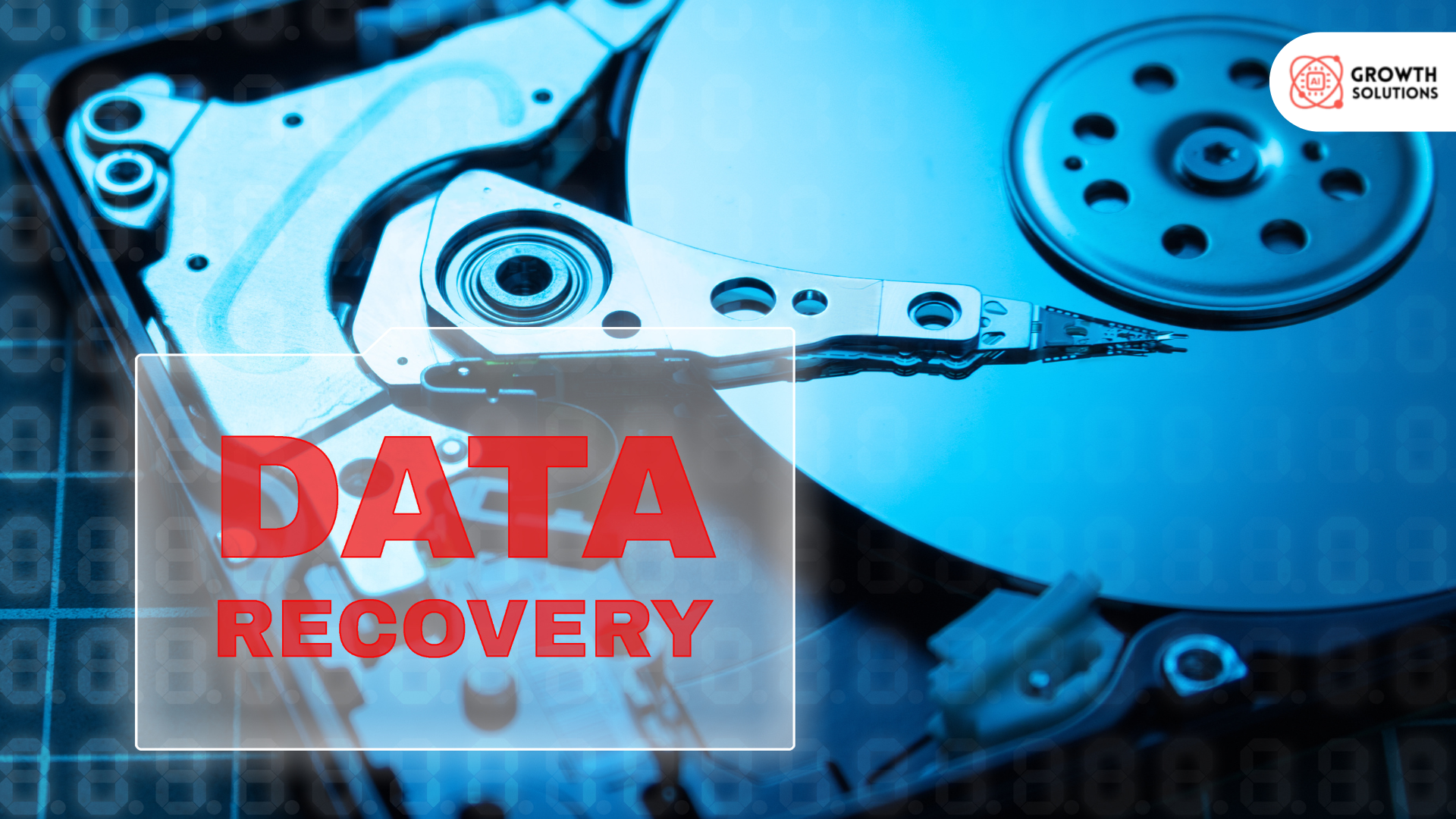18554493114
Call us for any question.
- support@aigrowth-solutions.com
- 349 Blue Point Rd Farmingville, NY 11738,USA
Call us for any question.
18554493114
Search for products
Blog Detail
- Home
- Blog
- Details
How Can Data Recovery Services Restore Deleted Files?
In today’s fast-paced digital world, data loss can happen at the most inconvenient times. Whether due to accidental deletion, hardware failure, or cyberattacks, losing important files can be catastrophic. Fortunately, Data Recovery Services offer a lifeline by restoring lost data and minimizing disruption. In this blog, we’ll walk through how Data Recovery Services work, the types of data loss they address, and why they are essential when data goes missing.
Understanding Data Deletion: What Happens to Your Files?
When you delete a file, it doesn’t necessarily vanish immediately from your storage device. Instead, the file’s location in the system’s directory is marked as free space. However, the data remains intact until it is overwritten by new information. This is where Data Recovery Services come into play. They can access the marked “free space” and restore the deleted file, provided it hasn’t been overwritten. Understanding this basic concept helps users grasp the importance of acting quickly after data loss.
Types of Data Loss: Common Scenarios That Require Recovery
Data loss can happen for various reasons, each requiring a different recovery approach. Some common scenarios where Data Recovery Services are essential include:
- Accidental Deletion: One of the most common reasons for data loss. A simple click can remove a critical file.
- Formatting or System Reinstallation: Sometimes, users format their drives or reinstall their systems without realizing important data is at risk.
- File Corruption: This can happen due to software crashes, sudden power loss, or disk errors.
- Malware or Ransomware Attacks: Malicious software can corrupt or encrypt files, making them inaccessible.
Each of these scenarios requires a different approach from IT Services or Data Recovery Customer Service, with some cases being more complex than others.
How Data Recovery Services Work: The Process Explained
When you reach out to Data Recovery Services, the first step is often a diagnostic to assess the condition of the device and the severity of the data loss. The process typically unfolds as follows:
-
Initial Assessment: Technicians examine the storage device to determine the cause of the data loss and the potential for recovery.
-
Data Imaging: For hard drives or SSDs that are mechanically failing, IT Services experts create a mirror image of the device to avoid further data loss during the recovery process.
-
Recovery Attempt: Using advanced software and techniques, Data Recovery Services scan the device for recoverable data, including deleted files that haven't been overwritten.
-
Data Restoration: Once the data is recovered, technicians transfer the files to a new, safe location, typically an external drive or cloud storage.
This method ensures that data is recovered as efficiently and safely as possible, and it highlights the importance of professional Data Recovery Customer Service.
File Recovery Software: How It Helps Restore Deleted Files
While there are many file recovery software options available for DIY attempts, they often come with limitations. Data Recovery Services typically use advanced, proprietary tools to recover files more effectively.
DIY software works by scanning your drive and attempting to recover lost files from the remaining traces. However, this software doesn’t always account for corrupted or fragmented data, making professional help necessary for complex cases. IT Services use advanced techniques, such as data carving and low-level scanning, to retrieve data that standard software cannot.
The Role of Hardware in Data Recovery
Not all data recovery cases are software-related. If your device’s hardware is damaged, Data Recovery Services often require specialized tools and environments, such as clean rooms. For instance, hard drives with physical damage, such as malfunctioning motors or stuck read/write heads, must be handled with extreme care.
Here are some common hardware-related issues that require professional intervention:
- Damaged Hard Drives: If your hard drive is physically damaged, such as from a fall, water exposure, or overheating, recovery needs to be done in a controlled, dust-free environment.
- Broken SSDs: Solid-state drives can fail due to electrical issues or manufacturing defects. Specialized techniques are used to extract data from these non-volatile memory devices.
Data Recovery Services equipped with the right technology, like disk imaging tools or repair labs, can successfully recover data from physically damaged drives, which DIY methods cannot address.
Recovering Files from Different Devices: PC, Mac, Smartphones, and More
The ability to recover data isn’t limited to desktop PCs or laptops. Data Recovery Services extend to smartphones, external hard drives, and even cloud storage systems. The methods used for each device can vary:
- PC and Mac Recovery: On desktops, file recovery is relatively straightforward as long as the storage drive is intact. IT Services can restore lost files from both Windows and macOS systems using specialized software and hardware.
- Smartphone Recovery: Deleting files from your smartphone doesn’t always mean they’re gone. For Android and iOS devices, Data Recovery Services use tools to recover data from internal storage or memory cards.
- External Drives: Whether USB sticks or external hard drives, these devices are prone to corruption or accidental formatting. Data Recovery Customer Service can help recover files from damaged or malfunctioning external drives.
- Cloud Storage Recovery: While cloud services back up your data, accidental deletion or corruption can occur. Data Recovery Services can sometimes recover lost files from cloud providers like Google Drive, OneDrive, or iCloud.
Understanding these differences is crucial when seeking recovery, as some methods require specialized software or tools.
The Importance of Timeliness: Why Acting Quickly Increases Recovery Success
The chances of recovering deleted files significantly decrease if new data is written to the device after the loss. The sooner you contact Data Recovery Services, the better the chances of successful recovery. Here’s why:
-
Overwriting Data: When new data is written, it can overwrite the space where deleted files are stored, making recovery much more difficult. The more you use the device after data loss, the harder it becomes to recover the original files.
-
Timing Is Critical: If you realize that you’ve lost important data, it’s crucial to stop using the device immediately and seek professional recovery services. The sooner you act, the higher the likelihood that IT Services can restore the files.
Data Recovery Services vs. DIY Methods: Why Professional Help Is Often Better
When it comes to recovering lost or deleted files, DIY methods may seem tempting, especially with free or low-cost software available online. However, Data Recovery Services are often a better choice for several reasons:
- Risk of Further Damage: Attempting DIY recovery can sometimes cause further data corruption, making professional recovery harder or even impossible.
- Advanced Tools: Data Recovery Services have access to advanced tools and techniques that can recover files from damaged or corrupted storage, something typical software cannot handle.
- Higher Success Rates: Professionals have extensive experience with data recovery and can often achieve better results than DIY software, especially when physical damage is involved.
While DIY methods can be useful in simple cases, when dealing with complex data loss, professional services are the best option.
Data Recovery from RAID and NAS Systems
RAID (Redundant Array of Independent Disks) and NAS (Network Attached Storage) systems present unique challenges for data recovery. These systems are commonly used by businesses to ensure high availability and data redundancy. However, RAID and NAS systems are more complex and often require specialized knowledge and tools.
- RAID Recovery: In a RAID system, data is spread across multiple disks. If one drive fails, data can still be accessed, but if multiple drives fail, the data recovery process becomes more complex. Data Recovery Services can use specific tools to rebuild the RAID array and recover the lost data.
- NAS Recovery: NAS systems store data over a network, making it more challenging to recover data from. Experts can use software and hardware solutions to access and retrieve data from NAS devices.
Understanding the complexities of RAID and NAS systems highlights why professional IT Services are needed for successful recovery in these cases.
How Long Does Data Recovery Take?
The length of time required to recover lost data depends on the complexity of the data loss. For simple cases of accidental deletion, recovery can be completed in a matter of hours. However, more complicated cases, such as data loss from damaged hardware or RAID systems, may take several days or even weeks. The key factors influencing recovery time include:
- Severity of the Data Loss: The more severe the damage or the more complex the loss, the longer the recovery process.
- Type of Storage Device: Hard drives and SSDs with physical damage take longer to recover than simple file deletions.
Data Recovery Customer Service can give you an estimate of how long the process will take once they assess the situation.
Conclusion
When data is lost, it’s important to remember that Data Recovery Services are the most reliable way to restore it. Whether it’s an accidental deletion, file corruption, or hardware failure, professionals have the tools and expertise to recover your data safely and efficiently. The longer you wait, the higher the risk of permanent data loss, so act quickly and reach out to IT Services for help. Professional Data Recovery Services offer the best chance for a successful recovery, ensuring your critical files are returned safely.
Category
Data Recovery
Previous Post
What Are the Most Common Causes of Data Loss?
In today’s world, data is an integral part of both our personal and professional lives. From i...
Next Post
Why Is Data Recovery Important for Businesses and Individuals?
In today’s fast-paced, data-driven world, losing access to your information can bring business...
Today's businesses span borders, requiring versatile solutions.



 Admin
Admin
